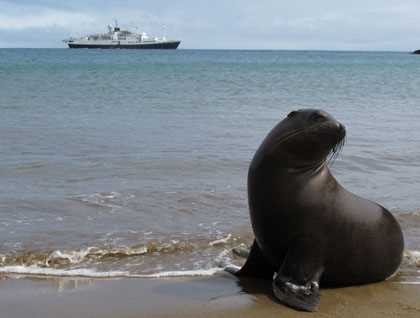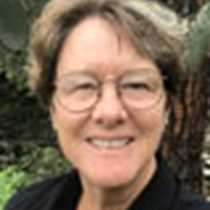This morning found us anchoring off Punta Pitt, the northwestern-most corner of one of the oldest islands in the archipelago of Galapagos. A dramatic landscape was laid out before us, perhaps exactly what Charles Darwin first saw on his arrival to these islands almost one hundred and eighty-eight years ago. Formed by the violent contact of molten magma and cold sea water, the original tuff cones of this area have been eroded away over the millennia to create fantastic sharp ridges and steep v-shaped ravines. The vegetation is sparse and adapted to the aridity of the region: the thorny scutia spicata var. pauciflora and the salt-tolerant bush cryptocarpus pyriformis as well as the unique clubleaf nolana galapagensis. Our explorations took the form of a serious hike up one of these ravines until we reached a plateau of open vistas. At the far end were low trees and bushes where red-footed boobies are nesting and the ocean seems to extend forever north. A recent census indicates their numbers to be increasing, a positive consequence to increased efforts by the Galapagos National Park to control introduced species such as feral cats and rats. Both these species arrived several hundred years ago with the first sailing vessels, and their descendants today are the focus of hard work, as they have a serious impact on many vulnerable, endemic species found no-where else in the world except Galapagos.
Some of us opted for a Zodiac ride in the area to find the red-footed boobies and other marine species. And find them we did! Flying around, nesting and roosting on Pitt Islet were the brown pelican, Galapagos shearwater, great and magnificent frigatebird, brown noddy tern, blue-footed booby and even the Nazca booby! This area is one of the few places in the entire archipelago where all three species of booby nest!
Before returning on board however, there was an opportunity to spend time on the landing beach; a very soft sand beach, green-tinged with olivine crystals and some young, playful sea lions. By the time folk were ready to go swimming, the cool mist from the inversion layer had burned off and the sun was bright. Some of us spent our time practicing a week’s-worth of photography tips, or searching (with success) for two more endemic species found only on San Cristobal Island: the lava lizard and mockingbird. Surely Darwin marveled at them as well on his first visit on shore in 1835! But in the end, everyone, and I mean everyone, was drawn to the water. Four young sea lions around six months to one year of age had decided that the humans were the most fascinating things they had seen in ages (and of course we thought the same, but vice versa). Many people got into the water for the experience of having these sleek creatures dive around them, jump around them and splash around them. The rest recorded the event for prosperity…and what a hoot it was for all! It was only with great reluctance that we finally left the golden beach of Punta Pitt to board once more our home-away-from-home. We had yet one more adventure…
…and was it ever!!! The intrepid went snorkeling at Leon Dormido, a majestic tuffcone remnant with excellent marine life. Literally dozens and dozens of black-tip sharks cruised underneath us as we snorkeled “shark alley,” the fissure between two massive cliffs. Fifty feet below us, a gentle white-sand slope could be seen because of superb visibility; school after school of small black-tip sharks, each group consisting of up to at least 25 individuals, swam serenely just feet underneath fast-beating human hearts. Off the underwater vertical rock face, numerous fish were also present, accompanied by the occasional sea turtle. Even some sea lions put in brief appearances, startling us with their size and speed, disappearing into the blue.
The National Geographic Endeavour circumnavigated the rock at sunset, and with champagne in one hand and our camera in the other, we couldn’t have chosen a better finale to a marvelous week.







